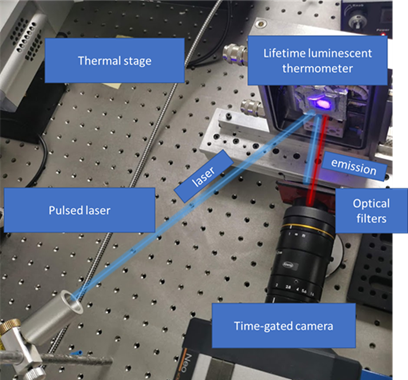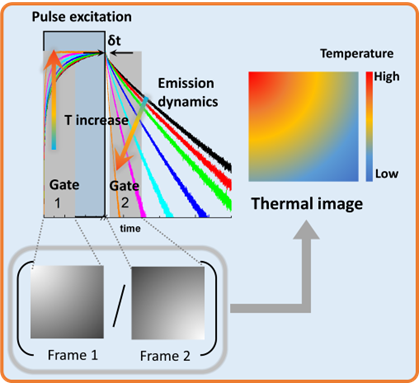Project Title:
Luminescence
Thermal Imaging System for Harsh Environments (LuTIS-HE)
Project Code:
PN-III-P2-2.1-PED-2019-2817
Contract Nr. :
297PED/2020
Project Funded by: UEFISCDI, Ministry of Education and Research, Romania
Period:
2020 -
2022 (24 months)
Project
Leader:
Carmen TISEANU
Contract
Value:
600.000 RON
Project Summary
The
project scope is to develop a Luminescence Thermometry
Imaging System for Harsh Environment (LuTIS- HE) based on
the photoluminescence of lanthanide ions (Ln) doped Y2O3
phosphors. The nano/microparticulate powders are used as
coatings on targeted surfaces. The proposed system is
optimized for the 80 - 877 K temperature range based on
non-contact self-referenced luminescence intensity ratio
(LIR) and lifetime thermometry methodology. A special focus
is placed on the energy applications in harsh environments
such as media with ionizing radiation and high magnetic
fields. The system is tested in media with ionizing
radiation (X-ray, with energy up to 320 keV), so that it can
used for monitoring the high -temperature components of
nuclear reactors. The project delivers the system at TRL4
(technology validated in lab) starting from the existing TRL
2 (technology concept formulated). The targeted key features
of LuTIS-HE are:
(1) Performance versatility (easy translation from visible
(400-800 nm) to near-infrared (NIR 800-1700 nm) in
luminescence detection or switching from luminescence
intensity ratio (LIR) to lifetime temperature reading
methodology);
(2) Mobility (the final system will be integrated on a
platform 2x1x1 m dimensions with easy assembly-
disassembly);
(3) Modularity (adding different add-on modules such as
microscope objective or fiber optic extension can extend the
functionality and performance of the system);
(4) High speed acquisition (greater than 10 frame per
second, fps);
(5) High thermometers performance (Relative thermal
sensitivity of >1.5%; temperature accuracy of 99%);
(6) User intuitive friendly;
(7) Application adaptability. The system can be easy
translated to bioimaging by using functionalized lanthanide
doped nanoparticles, microelectronics inspection; monitoring
catalytic reactions and nuclear fusion technology, to
monitor the online temperature of the superconducting tapes.
Project Team:
-
Carmen TISEANU (Project Leader)
-
Ioana POROSNICU (Phd Student)
- Adrian SIMA
(Msc Student)
- Cosmin DOBREA (Phd)
Project
Annual Reports:
Summary:
In this project stage, we synthesized a series of Ln doped Y2O3 nanoparticles as luminescent probes for temperature measurements. Therefore we select Eu, Dy, Tb, Pr, Nd, Ho, Er and Yb ions due to their emission properties in the visible and infrared spectral range. The phosphors selection was performed taking into consideration the evolution of the relative sensitivity (Sr) with temperature by implementing the following protocols:
1. Evaluation of the emission shape of a single transition or for two thermally coupled transitions ("Luminescence Intensity Ratio" method)
2. Lifetime measurements of the emission decay
Also, we performed a translation from thermometric measurements using spectroscopic techniques to thermography ("thermal imaging") using a sCMOS camera for "gated detection" type in the visible spectral range.
Contract Value: 225.000,00 RON
Stage 2021: "Design and construction of the luminescence temperature imaging system (LuTIS)"
Summary:
One of the most common and precise method for luminescence thermometry considers either the rise time or decay time of the emission. We developed a new thermographic method based on the simultaneous measurement of the emission rise and decay of either transitional or lanthanide metal activator (with emission in visible or NIR domain) after each excitation pulse. To validate the method, we select as luminescent probes the following nanoparticles: Cr-ZnGaGeO4/ZnGa2O4; Er, Ho, Yb -Y2O3; Er, Ho și Yb - β-NaYF4 with emission in the 450 - 1200 nm spectral range with timescale from 10 to 100 ms. By implementing our method, we obtained a maxim Sr that is almost double compared to the one obtained by the classical method (average lifetime method). Our method can be applied to any lifetime-based luminescent thermometer, opening a new avenue in designing accurate and straightforward lifetime thermal imaging systems operating in the Vis to NIR range.


Left- Experimental setup used for calibration of thermal imaging system which includes a thermal stage to control the temperature, a time-gated camera with appropriate optical filters, and a fiber-coupled excitation laser synchronized by a signal generator. Right - Schematic representation of the real-time thermal imaging method using single pulse time-gated detection. Frames 1 and 2 are acquired during and after the laser excitation pulse. The thermal image is obtained by the ratio of Frames 1 and 2 for every excitation pulse. Both emission rise and decay are monitored at their highest temporal intensity.
Contract Value: 280.000,00 RON
Stage 2022: "Developing the final thermal luminescence imaging system under harsh environment (LuTIS-HE)"
Summary:
In this stage, we developed the software of the system that allows real-time monitoring of thermal images, and we developed a protocol for optimizing the acquisition variables for the translation from imaging to video recording. Also, performance analysis of video recording of thermal images was performed under an ionizing radiation environment up to 320 keV. The results of these experimental validations make the object of a manuscript in progress that will be sent for publication after the registration of the patent application at the State Office for Inventions and Trademarks- OSIM (Romania).
Contract Value: 95. 000,00 RON
Project Publications and Papers Published in ISI Journals
1. D. Avram, I. Porosnicu, A.
Patrascu, C. Tiseanu "Real-time
thermal imaging based on the simultaneous rise and decay
luminescence lifetime thermometry" Adv. Phot. Res.,
(2022) 3(6), 2100208
2. Daniel Avram, Adrian Sima, Ioana
Porosnicu, Carmen Tiseanu "Thermal imaging under harsh
environment using luminescence lifetime thermometry" (work
in progress).
Patents
D. Avram, C. Tiseanu, I. Porosnicu "Metoda termografică cu rezoluție spațială și rezoluție de temperatură imbunătățite, bazată pe dinamica emisiei fosforilor." Romanian patent, OSIM application will be submitted after the CTTIM approval.
International Conferences
D. Avram, I. Porosnicu, A. Patrascu, C. Tiseanu "Thermal imaging using lifetime thermometry by monitoring both the rise and decay time" Third International Conference on Phosphor Thermometry (ICPT 2022), Magdeburg, Germany, 18 - 20.07.2022 (oral presentation).